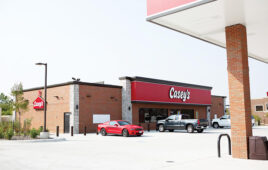By Brian L. Milne, Refined Fuels Editor Telvent DTN
Wholesale gasoline costs, including in the New York metropolitan market, eased coming into the final week of November. The decline comes as the post Sandy recovery for the region’s fuel infrastructure continues, with the final refinery shut ahead of the super storm expected to return to service this week.
The lower costs should pave the way for the seventh weekly decline in the Energy Information Administration’s (EIA) average retail gasoline price, which began the current string of lower averages on Oct. 15. EIA’s U.S. average for all formulations of regular grade gasoline sold at retail outlets has fallen from $3.85 gallon on Oct. 8 to a $3.429 gallon four-month low on Nov. 19.
In New Jersey, Hess reported normal operations at its 70,000 barrels per day (bpd) Port Reading refinery that was shut ahead of Hurricane Sandy, with the restart hampered by a loss of commercial power in the superstorm’s aftermath. Phillips 66 expects to have back online this week its 238,000 bpd Bayway refinery in Linden, which encountered power loss, flooding and damage to electric circuitry.
The returning refining capacity, especially with the Bayway restart, will continue to apply downward pressure upon the region’s spot gasoline prices. N.Y. Harbor spot RBOB has tumbled 27.35 cents since Nov.12 to Monday (11/26), with its cash differential the weakest since before Sandy’s landfall near Atlantic City in late October.
Gasoline stocks in New England, and in the central and lower Atlantic states posted their first weekly increases since before Sandy walloped the region. The refinery run rate for the PADD 1 East Coast averaged 67.5% of total regional capacity for the week-ended Nov. 16 after sliding to 58.5% of total capacity during the week-ended Nov. 2. This compares with a run rate for the region of 81% for the week in front of Sandy’s landfall, and as high as 89.9% in mid-October.
Demand Down Overall
Nationally, preliminary data from the EIA shows implied gasoline demand averaged 8.739 million bpd for the four weeks ended Nov. 16 which was 1.6% above the comparable year-ago period. However, from Jan. 1 through Nov. 16, implied gasoline demand has averaged 8.664 million bpd, down 300,000 bpd or 3.3% from the same timeframe for 2011.
The broader market is conflicted over concern of slowing economic growth for early next year, and its dampening effect on oil demand, and geopolitical risks to oil supply.
Ongoing haggling by creditors, euro leaders and officials with the International Monetary Fund over how to best address Greece’s mountain of debt leave the market’s concerned over a potential Greek default on its debt and what that would mean for the Euro zone economy.
In the U.S., Republican and Democrat leaders remain apart in addressing the Budget Control Act of 2011 commonly called the fiscal cliff, which refers to automatic government spending cuts and tax hikes that would take effect on Jan. 1. Concern, including from the Congressional Budget Office, is that the simultaneous spending cuts and tax hikes could push the U.S. back into a recession in early 2013.
View Telvent DTN’s Weekly and Historical Gasoline Price Index.
Although a ceasefire was reached between Israel and Hamas militants in the Gaza Strip after eight days of fighting and ahead of a planned escalation of hostilities, a power grab by the Egyptian president who brokered the ceasefire, Mohamed Morsi, almost immediately after the agreement has sparked protests while the Obama administration issued a rebuke. The fighting, including a civil war in Syria, and worry over civilian rule continue to spark worry over a potential disruption in the region’s oil supply, adding a geopolitical risk premium to oil prices.
About the Author
Brian L. Milne is the Refined Fuels Editor for Telvent DTN—a leading business-to-business provider of real-time commodity information services. Milne has been focused on the energy industry for 16 years as an analyst, journalist and editor. He can be reached at [email protected].




